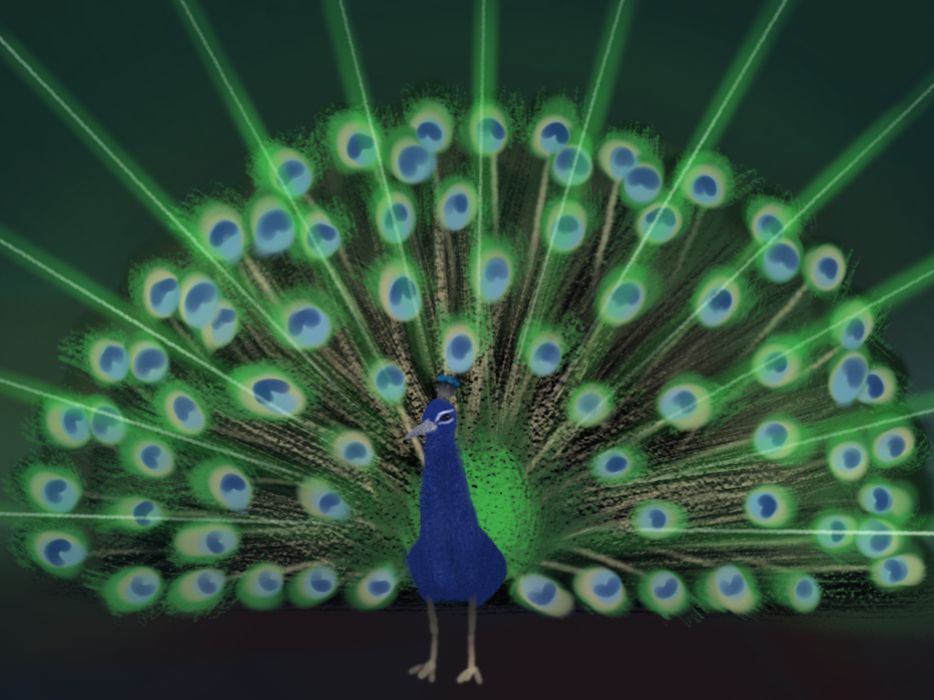Lasers and Peacocks
Peacock tails contain microstructures capable of producing laser light.
Reading Time: 4 minutes

From TV remote controls to eye surgery to TV spies dodging traps, lasers are everywhere in our lives. In recent scientific research, even peacock feathers can emit yellow-green laser light. Despite the word “laser” being commonplace in our daily conversations, it is actually an acronym for “light amplification by stimulated emission of radiation.” All light travels as an electromagnetic wave with its highest points at the peaks and lowest points at the troughs. Peaks and troughs alternate regularly. The wavelength of a wave is the distance between consecutive peaks or consecutive troughs. Lasers are composed of multiple beams of light, electromagnetic waves with similar wavelengths and that are in phase with each other—their peaks line up and their troughs line up. As a result, lasers do not spread as much as normal light, so they can travel for longer distances and concentrate a lot of energy in a small area, creating their characteristically bright and pointed light.
The mechanisms of lasers heavily involve the fundamentals of quantum physics. According to this scientific field, which focuses on the subatomic realm, energy is quantized. Quantized things can only be counted in discrete, or countable, units. For example, when you are climbing a staircase, you count how many “steps” you take. There is no unit smaller than that—no half-steps. Similarly, visible energy is quantized as packets of energy called photons.
These photons often interact with the electrons surrounding atomic nuclei. According to the Bohr atomic model, electron orbits are based on electron energy levels. The higher the energy level, the greater the electron’s distance from the nucleus. Photon-electron interactions can be described as absorption, spontaneous emission, or stimulated emission. In absorption, an electron absorbs a photon, which causes the electron to move to a higher energy level. In spontaneous emission, an excited electron naturally sinks to a lower energy level without any additional input of energy. For the total amount of energy to be conserved, this electron must emit a photon in the process. Finally, in stimulated emission, an incoming photon hits an already excited electron. The electron sinks to a lower energy level while spontaneously emitting another photon. This photon is identical to the incoming photon. The incoming photon and the emitted photon will have the same frequency (number of wave cycles per unit time), direction, and phase. As a result, there will be a combined wave with twice the amount of energy of each original photon in one direction.
Lasers take advantage of all three photon-electron interactions. Take a closed tube of gas with mirrors on both ends. The electrons from the gas molecules will begin in their ground state—the lowest energy level. A photon suddenly excites a few ground-state electrons during absorption. An excited electron emits a photon during spontaneous emission. This emitted photon then hits another excited electron, causing the second electron to undergo stimulated emission. Consequently, this second electron releases coherent protons, or in the same phase, with each other. The photons reflect off the peripheral mirrors, resulting in a feedback loop that releases more coherent photons. This laser light builds up within the tube. When it accumulates enough energy, the light eventually escapes the tube. Now observers can see coherent light with negligible variation in wavelength. In other words, laser light has been produced.
Laser light can also be produced within the microstructures of peacock tail feathers. Peacock tail feathers have reflective microstructures that are analogous to the mirrors needed for amplifying the laser beam. The hollow part of the tail, called the calamus, serves as the tube where photon-electron interactions take place. Researchers from Florida Polytechnic University and Youngstown State University applied external light and a special dye to a peacock feather to energize the electrons within it. During the experiment, the researchers noticed that the feather emitted narrow, coherent beams of yellow-green laser light. Hence, peacock tail feathers are an example of a biological laser, biological structures that facilitate laser production.
While the exact tail structures involved in laser production are not yet identified, this experiment can introduce potential applications of biological lasers. For example, new viruses with distinct geometrical structures can be classified and identified based on their laser-producing properties. Different viruses may produce lasers of different wavelengths and thus different colors, or not be able to produce any at all. This can advance sensitive medical diagnoses, as the type of laser produced in one viral microstructure would be different from that of another viral microstructure. Potential applications have even extended to preventive care. Biological lasers can become a new type of laser that is compatible with a patient’s body. As a result of this compatibility, biological lasers can be implanted inside the body to detect early signs of cancer. When a tumor spreads its cancer cells throughout the patient’s body, an internal laser can detect those cells. Beyond medical applications, similar lasers can be implemented to produce artificial colors. New colors can be produced by displays composed of patterned biomaterials, which may resemble honeycombs, exoskeletons, etc. The color can be altered by altering the reflective microstructures within biomaterials.
Peacock feathers shooting lasers may be a start to a new wave of laser technology. Future researchers can take advantage of other biological structures to advance our knowledge of lasers, anatomy, and potentially life-saving treatments. However, these biostructures must effectively accumulate light within a closed area. By integrating biology with physics, many answers to scientific questions could be hidden in plain sight within your very TV remote.
